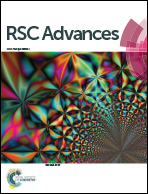[Cu(POP)(N^S)][PF6] and [Cu(xantphos)(N^S)][PF6] compounds with 2-(thiophen-2-yl)pyridines†
Abstract
A series of [Cu(POP)(N^S)][PF6] and [Cu(xantphos)(N^S)][PF6] compounds (POP = bis(2-(diphenylphosphino)phenyl)ether, xantphos = 4,5-bis(diphenylphosphino)-9,9-dimethylxanthene) in which the N^S ligand is a 2-(thiophen-2-yl)pyridine (1), 2-(thiophen-2-yl)-6-methylpyridine (2), 2-(5-methylthiophen-2-yl)pyridine (3) or 2-(5-methylthiophen-2-yl)-6-methylpyridine (4) have been prepared and characterized in solution and the solid state. Single crystal structures of [Cu(POP)(1)][PF6], [Cu(xantphos)(1)][PF6], [Cu(xantphos)(2)][PF6], [Cu(POP)(3)][PF6]·CH2Cl2, and [Cu(xantphos)(4)][PF6] confirm chelating N^S and P^P ligands, and distorted tetrahedral copper(I) centres. There is close cation⋯anion association, particularly in [Cu(xantphos)(1)][PF6]. Although the compounds are stable over days in CH2Cl2 solution, they are susceptible to the effects of competing ligands such as chloride ion and MeCN. Analysis of the NMR spectroscopic data of a solution of [Cu(POP)(3)][PF6] with added Cl−, gives a Kd value of 0.14 ± 0.03 mM, indicative of ion-pairing. [Cu(POP)(N^S)][PF6] and [Cu(xantphos)(N^S)][PF6] exhibit quasi-reversible or irreversible Cu+/Cu2+ oxidations. They are blue emitters in solution, and the presence of the 5-methyl group in the thiophene ring in 3 and 4 leads to a red-shift in the emission. The highest photoluminescence quantum yields are for [Cu(POP)(2)][PF6] (30.8%) and [Cu(POP)(4)][PF6] (33.2%), both of which have a 6-methyl-substituted pyridine ring in the N^S ligand. Excited-state lifetimes are <5 ns. On going from solution to powder samples, red-shifts of 133 to 163 nm are observed leading to yellow emitters. The brightest emitter, [Cu(xantphos)(1)][PF6], was tested in a LEC device but showed poor electroluminescence and poor charge transporting characteristics.
![Graphical abstract: [Cu(POP)(N^S)][PF6] and [Cu(xantphos)(N^S)][PF6] compounds with 2-(thiophen-2-yl)pyridines](/en/Image/Get?imageInfo.ImageType=GA&imageInfo.ImageIdentifier.ManuscriptID=C9RA02617G&imageInfo.ImageIdentifier.Year=2019)


 Please wait while we load your content...
Please wait while we load your content...